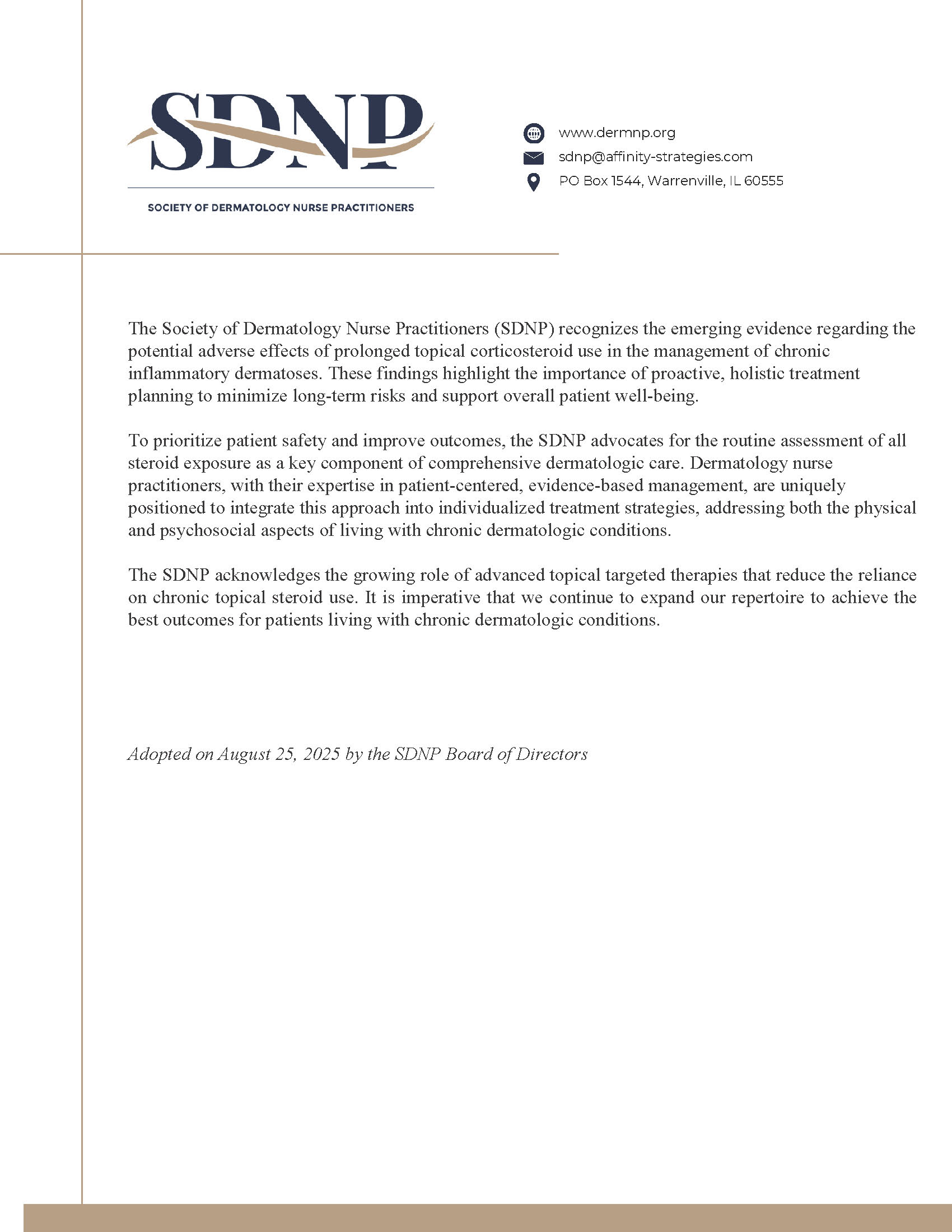Updates and ResourcesSDNP Statement Addressing the Total Administration of Corticosteroids for Patients with Chronic Dermatologic Conditions
MALIGNANT CUTANEOUS MELANOMA (MM)Malignant Melanoma is the most deadly form of skin cancer (Swetter, et al., 2019; Oakley, 2015). The rates of cutaneous melanoma doubled from 1982 to 2011 (Swetter, et al., 2019) and about 7,000 patients died as a result of MM in 2019. Risk factors for melanoma include sun exposure, tanning bed use (particularly in women less than 45 years of age), more than 50 moles or those with atypical moles, immediate family history of melanoma, fair skin, blue eyes and previous non melanoma skin cancer or other cancers such as breast or thyroid CA (Swetter, et al., 2019; Oakley, 2015). About 75% of melanomas initiate from an existing nevus. Common locations for melanoma for men include the back and for women, it is found more often on the lower extremities. Melanoma less commonly occurs on the genitals, lips, eyes, palms and soles. In situ melanoma (MMIS) occurs only within epidermis of the skin (Oakley, 2015). Invasive melanoma indicates that it has spread to the dermis. Metastatic melanoma indicates a spread to other organs or tissue. The presentation of melanoma typically follows the ABCDE rules: asymmetry, border irregularity, color variation, diameter greater than 6 mm and/or evolving (Oakley, 2015). There are multiple types of cutaneous melanoma. Superficial spreading type is the most common and typically originates from a pre-existing nevus. Nodular melanoma is typically dome shaped or ulcerated and occurs de novo. It is less common and represents about 15% of MMs. Lentigo Maligna Melanoma is a form of MMIS that develops over five to twenty years. It occurs in sun exposed areas, normally the face, neck or ears. Other examples of less common forms of melanoma include nail and acral melanomas, amelanotic melanoma, regressing melanoma and desmoplastic melanoma. Below is a summary of the American Academy of Dermatology (AAD) guidelines for management of primary cutaneous melanoma that was published in 2019. Biopsy technique
PathologyThe AAD recommends that the pathologist provide the following in the pathology report for a melanoma:
Staging - The Basics
A description of melanoma staging was developed by the American Joint Committee on Cancer and a summary is found in the AAD guidelines (Swetter, et al., 2019, pg. 213). Treatment of MelanomaWide Local Excision is the standard of care for melanoma. Surgical margin recommendations are based on the Breslow depth of the melanoma as follows:
Sentinel Lymph Node Biopsy SummaryA blue dye is injected around the primary melanoma. The surgeon uses a gamma probe to identify the afferent lymph node reservoirs that light up from the blue dye and sample those nodes. A positive SNL biopsy has an established poorer prognosis and negative SNL biopsies typically have better prognosis. The SNL biopsy should be performed at the same time or prior to the excision of the primary melanoma, which allows the correct lymphatic channels to be identified and produces a more accurate SNL biopsy.
Monitoring
Second Line Treatments
Follow up
Pregnancy and MelanomaThere is not enough evidence to support that pregnancy is a risk factor for MM. Women in general have a higher rate of melanoma, and especially young women in their reproductive years. Melanoma is the most common cancer to occur during pregnancy. However, several studies have found no causal link between MM and pregnancy, and results are conflicting. Currently, melanoma that does occur in pregnant women is thought to be more likely related to tanning bed use or sun exposure habits. There is no recommendation for a woman with a history of melanoma to postpone conception after treatment. There is no contraindication for biopsying a suspicious nevus in a pregnant woman. There are also no contraindications for oral contraceptive therapy, hormone replacement therapy, in-vitro fertilization or other hormonal treatments for women with a history of MM. ReferencesOakley, A. (2015). Melanoma. DermNet NZ. https://dermnetnz.org/topics/melanoma/. Swetter, S., Tsao, H., Bichakjian, C., Curiel-Lewandrowski, C., Elder, D., Gershenwald, J., Guild, V., Grant-Kels, J., Halpern, A., Johnson,T., Sober, A., Thompson, J., Wisco, O., Wyatt, S., Hu, S. & Lamina, T. (2019). Guidelines of care for the management of primary cutaneous melanoma. Journal of the American Academy of Dermatology, 80(1), 208–250. https://doi.org/10.1016/j.jaad.2018.08.055. |


























